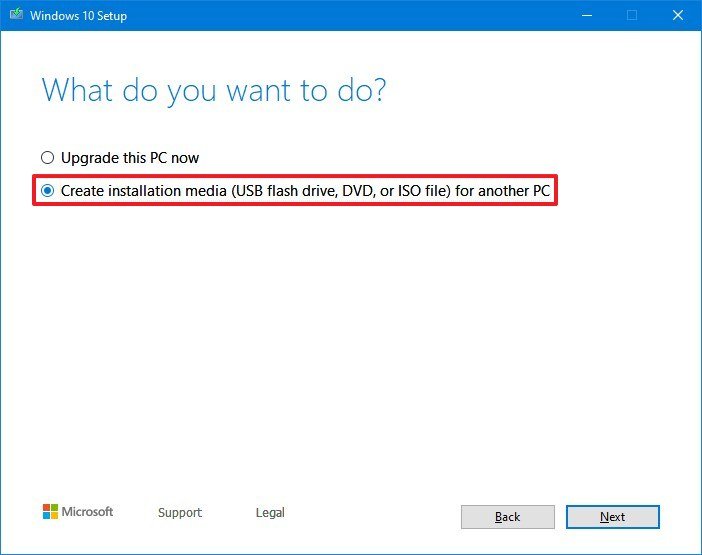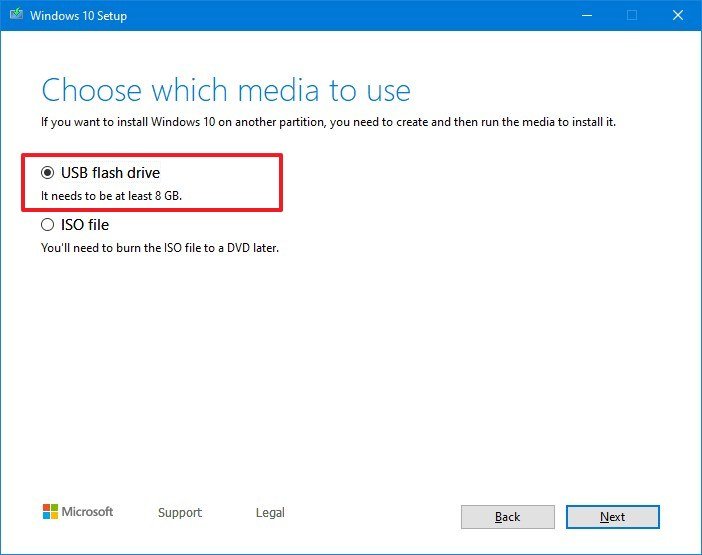
About to install Windows 10 on a PC using UEFI? Use these steps to create a compatible USB bootable media to perform this task.
When you have to install a clean copy of Windows 10, typically, you'll need a USB bootable media to start your device and continue with the setup wizard. However, if you're using a computer that features a Unified Extensible Firmware Interface (UEFI), instead of the legacy Basic Input/Output System (BIOS), you have to make sure that the media will work with your motherboard firmware type.
If you're using a newer firmware type, there are various methods that you can use to create a media to install Windows 10 from USB. Although Microsoft doesn't say it aloud, you can use the Media Creation Tool to download the installation files onto a removable drive with support for both UEFI and legacy BIOS. Alternatively, you can also use Rufus, which is a third-party tool that makes it easy to create an installation boot media with support for UEFI.
In this Windows 10 guide, we'll walk you through the steps to create a USB flash drive that includes UEFI support using the Microsoft Media Creation Tool and Rufus.
- How to create a Windows 10 UEFI boot media using Media Creation Tool
- How to create a Windows 10 UEFI boot media using Rufus tool
How to create a Windows 10 UEFI boot media using Media Creation Tool
If you have a system using UEFI, you can use the Media Creation Tool to create a bootable USB media to perform an in-place upgrade or clean installation of Windows 10.To create a bootable media, connect a USB flash drive of at least 8GB of space, and then use these steps:
- Open Windows 10 download page.
- Under the "Create Windows 10 installation media" section, click the Download tool now button to save the file on your device.

- Double-click the MediaCreationToolxxxx.exe file to launch the tool.
- Click the Accept button to agree to the Microsoft terms.
- Select the Create installation media (USB flash drive, DVD, or ISO file) for another PC option.

- Click the Next button.
- Clear the Use the recommended options for this PC option (if applicable).
- Select the correct language, architecture, and edition of Windows 10.

Quick tip: If you'll be installing Windows 10 on multiple devices running 32-bit and 64-bit architectures, then use the "Architecture" drop-down menu and select the Both option. - Click the Next button.
- Select the USB flash drive option.

- Click the Next button
- Select the removable drive from the list. (If you don't see the drive, click the Refresh drive list option.)

- Click the Next button.
- Click the Finish button.
How to create a Windows 10 UEFI boot media using Rufus tool
If the Media Creation Tool isn't working, you can use Rufus to create an installation media with UEFI support using an existing ISO file. Or you can also use the tool to download the Windows 10 files from the Microsoft servers and create the bootable flash media.Creating boot media with Windows 10 ISO
To create a bootable media using a Windows 10 ISO file that you already have, connect a USB flash drive of at least 8GB of space, and use these steps:- Open Rufus download page.
- Under the "Download" section, click the latest release of the tool to save the file on your device.

- Double-click the Rufus-x.x.exe file to launch the tool.
- Under the "Device" section, select the USB flash drive with at least 8GB of space.
- Under the "Boot selection" section, click the Select button on the right side.
- Select the Windows 10 ISO file from its folder location.
- Click the Open button.
- Use the "Image option" drop-down menu to select the Standard Windows installation option.
- Use the "Partition scheme" drop-down menu to select the GPT option.
- Use the "Target system" drop-down menu to select the UEFI (non CSM) option.

- Under the "Show Advanced drive properties" section, leave the default settings.
- Under the "Volume label" field, enter a descriptive name for the drive — for example, "win10_1909_usb."
- Under the "File system" and "Cluster size" section, leave the default settings.
- Click the Show advanced format options button.
- Select the "Quick format" and "Create extended label and icon files" options.
- Click the Start button.
- Click the OK button to confirm.
- Click the Close button.
Creating boot media downloading Windows 10 ISO
If you don't have a Windows 10 ISO file, you can use Rufus to download the ISO from the Microsoft servers and create the bootable USB flash media. Connect a USB flash drive of at least 8GB of space, and use these steps:- Open Rufus download page.
- Under the "Download" section, click the latest release of the tool to save the file on your device.

- Double-click the Rufus-x.x.exe file to launch the tool.
- Under the "Device" section, select the USB flash drive with at least 8GB of space.
- Under the "Boot selection" section, click the arrow button next to the "Select" option, on the right side, and choose the Download option.

- Click the Download button.
- Use the "Version" drop-down menu and select Windows 10.
- Click the Continue button.
- Select the 19H2 (Build 18363.418 - 2019.11) option to download the Windows 10 November 2019 Update.
- Click the Continue button.
- Use the "Edition" drop-down menu and select the Windows 10 Home/Pro option.
- Click the Continue button.
- Use the "Language" drop-down menu and select your installation language.
- Click the Continue button.
- Use the "Architecture" drop-down menu and select the 32-bit or 64-bit (recommended).
- Click the Download button.

- Select a folder location to temporarily download the ISO file from the Microsoft servers.
- Click the Save button.
- Use the "Image option" drop-down menu to select the Standard Windows installation option.
- Use the "Partition scheme" drop-down menu to select the GPT option.
- Use the "Target system" drop-down menu to select the UEFI (non CSM) option.

- Under the "Show Advanced drive properties" section, leave the default settings.
- Under the "Volume label" field, enter a descriptive name for the drive — for example, "win10_1909_usb."
- Under the "File system" and "Cluster size" section, leave the default settings.
- Click the Show advanced format options button.
- Select the "Quick format" and "Create extended label and icon files" options.
- Click the Start button.
- Click the OK button to confirm.
- Click the Close button.
Now that you have a USB bootable media with support for UEFI, you can start your computer to perform an in-place upgrade or clean installation of Windows 10.
